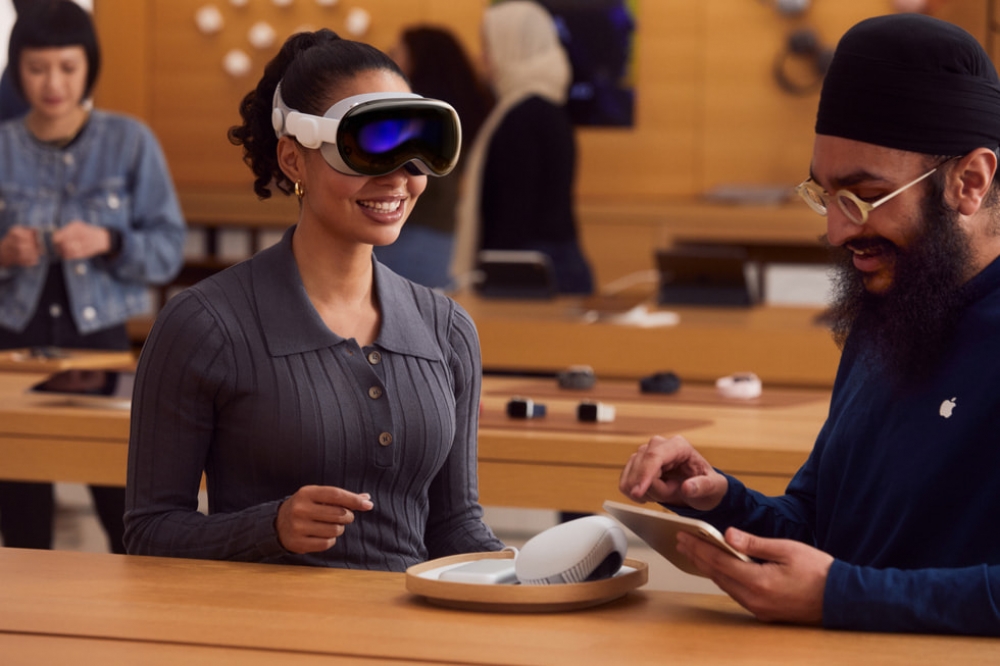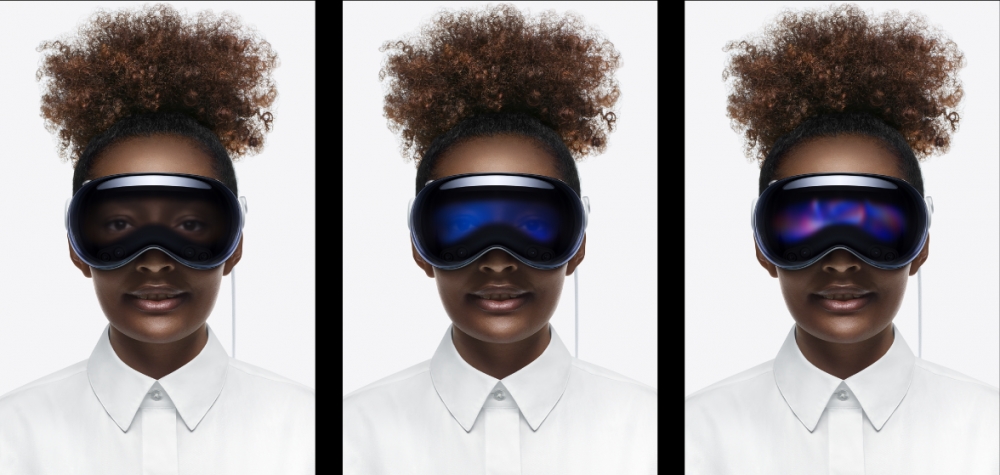6 Months Later: Surprising Things You Should Know About the Apple Vision Pro
- Apple’s Vision Pro: The future of computing or just a pricey gimmick?
- Six months in, the Vision Pro's revolutionary promise feels a bit flat.
- Can Apple’s $3,499 headset turn the tech world upside down, or is it doomed to a Google Glass future?
Six months into its release, Apple’s Vision Pro has had time to settle into the tech landscape. Announced with much fanfare, this so-called “spatial computer” promised to be Apple’s most ambitious product since the iPhone. The Vision Pro is a mixed-reality headset, blending augmented reality (AR) and virtual reality (VR) into a device designed to fundamentally change how we interact with the digital world. But has it lived up to the hype?
 Photo via CNBC // The Apple Vision Pro got people talking when it was announced, but is it enough to win over consumers?
The Vision Pro isn’t just another VR headset. It’s an ultra-high-end device with dual 4K micro-OLED displays, an M2 chip, and an array of sensors that track eye movement and gestures, allowing users to navigate without a traditional controller. The aim? To create a fully immersive experience where digital content is seamlessly integrated into the physical environment. Apple’s pitch was that this is the future of computing—where screens and devices melt away, leaving only the content.
Photo via CNBC // The Apple Vision Pro got people talking when it was announced, but is it enough to win over consumers?
The Vision Pro isn’t just another VR headset. It’s an ultra-high-end device with dual 4K micro-OLED displays, an M2 chip, and an array of sensors that track eye movement and gestures, allowing users to navigate without a traditional controller. The aim? To create a fully immersive experience where digital content is seamlessly integrated into the physical environment. Apple’s pitch was that this is the future of computing—where screens and devices melt away, leaving only the content.
Yet, six months after launch, the Vision Pro has encountered more skepticism than applause. While Apple may have envisioned a future where we all don spatial computers to work, play, and communicate, reality has been a bit more complicated.
One of the biggest hurdles the Vision Pro faces is its price. At $3,499, it’s one of the most expensive pieces of consumer tech Apple has ever released. This price tag alone limits its audience to a niche market of early adopters and tech enthusiasts. In a world where even the latest iPhones and Macs are pushing the boundaries of affordability, the Vision Pro’s cost makes it a hard sell for the average consumer.
 Photo via Apple Inc. // A woman uses Apple Vision Pro in an Apple Store.
Moreover, the Vision Pro’s software ecosystem has yet to provide a compelling reason for most people to make that investment. Apple promised a revolution in how we interact with digital content, but so far, the apps and experiences available haven’t delivered on that promise. Many critics have pointed out the lack of a “killer app”—the must-have application that would justify the purchase. This is reminiscent of the early days of the iPad, which also struggled to find its footing until developers figured out how to harness its potential. But the difference here is that the iPad was priced to be a mass-market device from the start. The Vision Pro doesn’t have that luxury.
Photo via Apple Inc. // A woman uses Apple Vision Pro in an Apple Store.
Moreover, the Vision Pro’s software ecosystem has yet to provide a compelling reason for most people to make that investment. Apple promised a revolution in how we interact with digital content, but so far, the apps and experiences available haven’t delivered on that promise. Many critics have pointed out the lack of a “killer app”—the must-have application that would justify the purchase. This is reminiscent of the early days of the iPad, which also struggled to find its footing until developers figured out how to harness its potential. But the difference here is that the iPad was priced to be a mass-market device from the start. The Vision Pro doesn’t have that luxury.
Another challenge is the sheer complexity of the Vision Pro. Unlike an iPhone or a Mac, which are intuitive and familiar, the Vision Pro requires users to learn new ways of interacting with technology. Eye tracking, hand gestures, and voice commands are all central to the experience, but they’re also new and unfamiliar to most people. There’s a learning curve, and it’s not clear if consumers are willing to invest the time and money to climb it.
 Photo via Apple Inc. // Apple Vision Pro has a display on the front of the device, for a technology Apple calls EyeSight. EyeSight makes your eyes visible to those around you by using a 3D scan of your face taken with the $3,499 device.
That said, there are reasons to be optimistic about the Vision Pro’s future. Apple has a track record of playing the long game with its products. The first Apple Watch, for instance, was met with mixed reviews, but subsequent iterations refined the hardware, improved the software, and ultimately turned it into a best-seller. The Vision Pro could evolve in much the same way, especially if Apple can convince developers to create the kinds of experiences that truly showcase what the device is capable of.
Photo via Apple Inc. // Apple Vision Pro has a display on the front of the device, for a technology Apple calls EyeSight. EyeSight makes your eyes visible to those around you by using a 3D scan of your face taken with the $3,499 device.
That said, there are reasons to be optimistic about the Vision Pro’s future. Apple has a track record of playing the long game with its products. The first Apple Watch, for instance, was met with mixed reviews, but subsequent iterations refined the hardware, improved the software, and ultimately turned it into a best-seller. The Vision Pro could evolve in much the same way, especially if Apple can convince developers to create the kinds of experiences that truly showcase what the device is capable of.
In the end, the Vision Pro’s success—or failure—will hinge on whether Apple can make good on its promise of a spatial computing revolution. The technology is undeniably impressive, but tech for tech’s sake isn’t enough. Apple needs to show consumers why they need this device in their lives and, more importantly, why it’s worth the hefty price tag.
As we pass the six-month mark, it’s clear that the Vision Pro is still very much a work in progress. Whether it becomes the next iPhone or joins the ranks of Apple’s less successful ventures remains to be seen. For now, the Vision Pro is a fascinating glimpse into a possible future—but one that has yet to fully arrive.
Recommended by the editors:
Thank you for visiting Apple Scoop! As a dedicated independent news organization, we strive to deliver the latest updates and in-depth journalism on everything Apple. Have insights or thoughts to share? Drop a comment below—our team actively engages with and responds to our community. Return to the home page.Published to Apple Scoop on 23rd August, 2024.
No password required
A confirmation request will be delivered to the email address you provide. Once confirmed, your comment will be published. It's as simple as two clicks.
Your email address will not be published publicly. Additionally, we will not send you marketing emails unless you opt-in.